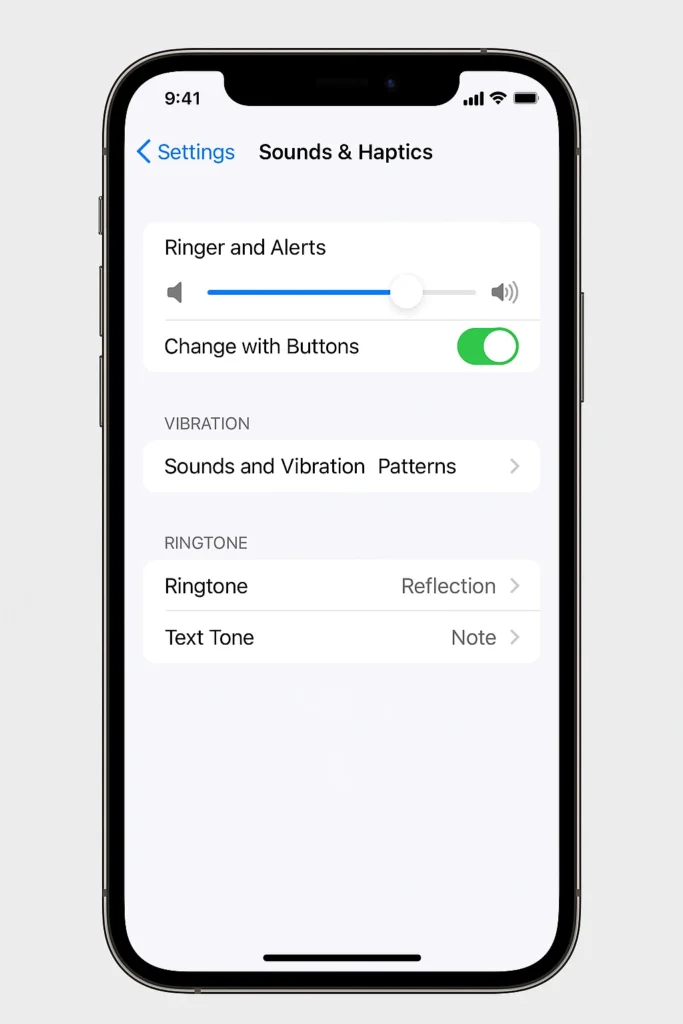Waking up on time is crucial, and your iPhone’s alarm plays a big role in it. But if the alarm is too loud, it can be startling, and if it’s too soft, you might oversleep. Many iPhone users are surprised to learn that the alarm volume isn’t controlled by the media volume (used for music or videos) but by the Ringer and Alerts volume. This guide walks you through everything you need to know about changing the alarm volume on your iPhone.
How to Change Alarm Volume on iPhone in Settings
To adjust the alarm volume:

- Open the Settings app.
- Tap Sounds & Haptics (on older iPhones it may appear as Sounds).
- Under Ringer and Alerts, drag the volume slider left (quieter) or right (louder).
- While dragging, your iPhone will play a sample tone so you can hear the change.
- Toggle Change with Buttons if you want to use the side buttons for alarm volume.
Adjust iPhone Alarm Volume with Side Buttons
If Change with Buttons is turned on:
- Press the Volume Up or Volume Down button on the left side of your iPhone.
- A Ringer notification will appear on-screen (on newer models with Dynamic Island, it shows at the top).
- This adjustment affects your alarm volume too.
Best Alarm Sounds on iPhone for Heavy and Light Sleepers
Sometimes, the issue isn’t just the volume—it’s the sound you pick.
- Open the Clock app.
- Go to the Alarm tab and edit an alarm.
- Tap Sound and preview different tones.
- Louder options include Radar, Beacon, and Reflection.
- Softer options include Silk, Chimes, and Ripple.
How to Test Your Alarm Volume
To avoid surprises in the morning, do a quick test:
- Set an alarm a minute or two ahead.
- Place your phone on a table and wait for it to ring.
- Adjust the volume or sound if needed.
- Delete the test alarm afterward.
Extra Troubleshooting Tips
If your alarm still feels off, here are common issues and fixes:
- Alarm too quiet or only vibrates
- Check the Ringer and Alerts slider in Settings > Sounds & Haptics. Also confirm your alarm sound isn’t set to None in the Clock app.
- Using headphones
- Alarms still play through the built-in speakers even when headphones (wired or wireless) are connected.
- StandBy mode
- Alarm haptics are disabled when using StandBy. The sound will still play, but without vibration feedback.
- Silent mode and Do Not Disturb
- These do not silence alarms. They will always ring at the Ringer and Alerts volume.
- Manual time changes
- Avoid manually changing the iPhone’s system time to trick apps, as this can interfere with alarms.
Related Guides You Might Like:
- How to Fix iMessage Activation Failed on iPhone
- How to Fix com.apple.mobilephone error 1034 on iPhone (Easy Step-by-Step Guide)
- How to Fix ‘Error While SRP Initial Authentication’ on iPhone
- How to Fix Inverted Camera on iPhone After iOS 18 Update
- How to Fix HTML5_video:4 Error on iPhone: Troubleshooting Video Playback Issues
Changing the alarm volume on your iPhone is simple once you know it’s tied to Ringer and Alerts, not media sound. By adjusting the slider in Settings > Sounds & Haptics, choosing the right alarm tone, and testing before bed, you’ll never have to worry about missing—or being jolted awake by—your morning alarm again.

